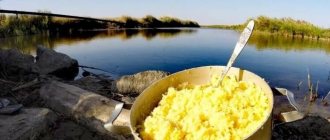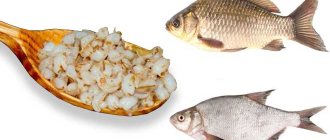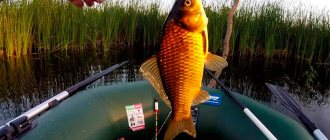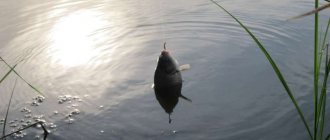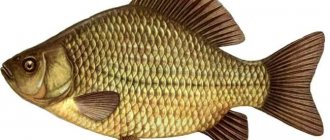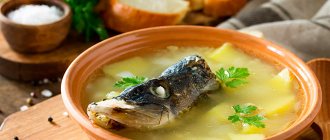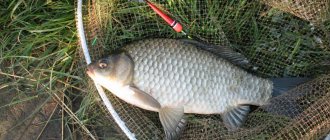Properties of rolled oatmeal for catching crucian carp
All carp fish (for example, bream or roach) love oatmeal, so it is used as an independent product and is an integral part of many complementary foods (5–10%). This is also facilitated by the excellent astringent properties of the flakes.
The product has an attractive smell and taste, its delicate consistency encourages crucian carp to more readily take all the bait. Simply scattering grain is not recommended because the fish quickly become saturated, which leads to a decrease in bite.
How to use in bait
Fish bait is prepared by the fisherman from several components. Most take crackers and porridge as a basis, which is most often prepared from oatmeal.
Hercules provides the following functions for bait:
- glues all ingredients together;
- provides fractions of different weights (coarse and medium);
- absorbs well and gives off odor.
To prepare bait, it is recommended to first fry large flakes in a frying pan or in the oven until light golden brown. They will then become resistant to water and retain their shape, and the stickiness of the mixture can be adjusted by finely sifting rolled oats, which are not fried.
Important! Experienced fishermen separate baits for warm and cold water, the boundary between which is at a temperature of +12°C.
In warm water, carp fish react to special substances added to the mixture for aromatization.
Preparing the mixture for fishing
Many “working” recipes for making oatmeal have been invented. We will look at one of them.
Have to take:
- rolled oats;
- an old sock or stocking;
- fine mesh colander;
- corn or wheat flour;
- flavorings;
- pan or some kind of container.
Preparation:
- Measure out the required amount of flakes, sift them through a sieve to remove various debris and defects, and pour them into a nylon stocking.
- Pour water into a saucepan and boil it.
- Place the stocking with cereal in boiling water, not forgetting to add salt (sugar).
- Cook them for 15-20 minutes.
- After this time, remove the rolled oats from the stocking and place them on a clean cloth so that the flakes lie freely and do not come into contact with each other. Otherwise, the rolled oats will stick together and the mixture will not “work.” It’s better not to take newspaper: the nozzle will absorb the smell of printing ink, and the fish really don’t like it.
- Next, the flakes are sprinkled with flour or breading, covered with paper, and left for several hours to “ripen.” The result is a high-quality fishing bait.
Read: How to easily catch caddisfly for fishing in any season
How to put rolled oats on a hook
To securely fix the rolled oats on the hook, you can use a piece of potato. Several “petals” are placed on the cut of the vegetable, and then pierced with a hook, inserting the point directly into the potato. A support made of bread or pearl barley will help to avoid rapid removal when casting. Some fishermen make a “chamomile”, for which the flakes are unfolded on a hook in different directions in the form of a flower.
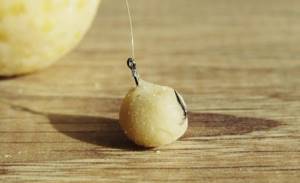
Features of catching crucian carp with rolled oats
In the water, the bait gets wet over time and a cloudy cloud of small parts of oatmeal appears, which will attract fish. If the crucian carp does not bite, you should perform several re-casts so that the bait flies off.
Did you know? Crucian carp has a very developed sense of smell and easily distinguishes even parts per million of substances dissolved in water. This fish is also partial to unusual odors, such as Corvalol or kerosene.
In this case, at the bottom of the reservoir, the settled rolled oats will spread an appetizing smell and lure the fish, which will first try individual flakes and then proceed to large bait. Using prepared rolled oats at one fishing spot, you can collect a large number of crucian carp there, waiting for a tasty treat.
How to cook rolled oats for fishing: the best recipes from experienced fishermen
Many species of fish bite well on bait of plant origin. When crucian carp or bream refuses steamed pearl barley or peas, then oatmeal can help out the fisherman.
The fish instantly reacts to the fragrant bait, confidently swallowing it along with the hook. Unfortunately, when dry, the nozzle quickly washes away in water.
In order not to worry about the condition of the oatmeal on the hook, you should know how to prepare rolled oats for fishing.
Properties of rolled oats, details of manufacturing
Hercules are oatmeal flattened in special equipment. The result is smooth or grooved petals, which cook much faster than cereal.
Before the oat grains are sent to the flattening apparatus, they are cleaned, polished and steamed. This manufacturing technology makes the grains soft, which subsequently has a positive effect on the speed of cooking.
By rolling the grains, the specific surface area increases, which also helps reduce cooking time.
Since Soviet times, the food industry has offered the population three types of oatmeal:
- for rolled oats, the cooking time is 20 minutes;
- It only takes 10 minutes to prepare petal flakes;
- The thinnest and fastest-cooking flakes are the extra grade flakes.
The fact that rolled oats is good for human health has been successfully proven by scientists from different countries. Many of the beneficial properties of oatmeal are also appreciated by fish.
- Hercules is a source of polysaccharides (carbohydrates), due to which the energy level of a living organism is maintained without sharp fluctuations.
- Polysaccharides take longer to process in the gastrointestinal tract than disaccharides or glucose, which is why the feeling of fullness lasts for a long time.
- Oatmeal contains a lot of dietary fiber, which improves heart function and reduces cholesterol.
- Oatmeal has excellent astringent properties, which fishermen use when preparing bait mixtures.
Photo 1. Oatmeal is good for groundbait and bait.
Working recipes for making bait
Those fishermen who do not know how to prepare rolled oats for fishing try to use dry flakes. If it is somehow possible to overcome the problem of mounting, then people cannot prevent rapid erosion in water. Only in stagnant water can you catch active crucian carp with such a bait. It’s better to use one of the working recipes to make the attachment indelible.
Steaming
One of the simplest options for preparing rolled oats is steaming the flakes in boiling water.
- A portion of rolled oats is poured into a metal strainer. It is better to boil water in a kettle.
- Then the flakes are treated with boiling water for about 10-20 seconds. The exact time depends on the type of oatmeal and the manufacturer.
- After heat treatment, it is necessary to remove excess moisture, which is achieved by shaking the strainer.
- The steamed flakes are scattered in a thin layer onto clean paper. It is advisable not to allow several particles of the nozzle to stick together.
- The top layer of rolled oats is covered with another sheet of paper and pressed with a weight weighing up to 2 kg.
- Once cooled, oat flakes can be used as bait.
Recommendation!
Experienced fishermen advise using high-quality paper. Then the flakes will not overheat, and the moisture will quickly be absorbed into the paper.
Brewing
You can make an excellent addition from rolled oats by brewing the flakes. This recipe is used by many people on a diet. But there is some difference in preparation in relation to fishing bait.
- Boil water in a small saucepan. While the water is heating up, a portion of rolled oats is poured into a gauze bag.
- Place a bag of cereal in boiling water for 20-30 seconds. After this, the gauze bag is removed from the boiling water and cooled in air.
- As soon as you can touch the bait with your hands, you should knead the pulp to give it a uniform structure. The longer the oatmeal cools, the more sticky the bait will be.
- On a pond, you need to pinch off a small piece from the dough-like mass and place it on a hook.
Kneading the dough
Some fishermen like to make the usual dough out of rolled oats, which the fish like.
- First, the flakes can be turned into flour by passing rolled oats through a coffee grinder. It is allowed to add cereals such as pearl barley or millet when grinding.
- The crushed mixture is mixed with warm water in such a ratio that a dense and viscous mass is obtained. You can use canned corn liquid or egg yolk instead of water.
- One of the flavorings is added to the dough. It will be enough to pour in a few drops of valerian or anise to give the nozzle additional attractiveness.
Features of using rolled oats in bait
Rolled oats work great as one of the components of bait. The use of oatmeal allows you to collect large fish on the bait spot. Bream reacts especially sensitively to the aroma of oatmeal.
But fishermen do not always correctly use this important ingredient when preparing the feed mixture.
- Crushed rolled oats are an excellent binding agent. It makes the bait sticky, and when it gets into the water it forms a cloud of turbidity. However, you just need to re-moisten the composition, and the fisherman will get a solid piece. It is very difficult to loosen such bait and bring it into proper condition.
- At the same time, fishermen add rolled oats flakes to make the composition more loose. Getting to the bottom, a lump with such a leavening agent disintegrates faster, which attracts medium and large fish. Individual particles of oatmeal float to the surface or hang in the water column. But the main part of the bait covers the bottom surface away from the shore.
One of the most popular recipes allows you to make a special porridge for catching crucian carp with a spring. The cooking technology looks like this.
- Millet cereals are washed, poured into a pan and filled with water. A liter of water requires 1 glass of cereal. Cook the millet porridge over low heat until done. It is better to carry out cooking operations with millet in an aluminum rather than an enamel pan.
Advice!
To obtain a homogeneous mass, you need to constantly stir the porridge. Millet is different in that it tends to burn.
Rolled oats flakes also work well as bait on a hook when catching peaceful carp fish, especially crucian carp and roach. To prevent the grain from cracking when planting, they use one trick - potatoes.
Photo 2. Flakes on potatoes.
It turns out a neat Herculean nozzle.
Photo 4. Flakes on a hook.
Oatmeal flakes planted in this way stick perfectly to the hook. At the same time, they soak in the water and emit a pleasant aroma for the fish, additionally attracting it to the hook.
Source: https://fishelovka.ru/lures-bait/recepty-prigotovleniya-nasadki-na-osnove-gerkulesa-dlya-rybalki
The simplest recipe for making rolled oats
To prepare rolled oats for fishing, we need a small strainer of this type:
We place the cereal into it by 1/3 of the volume, and pour boiling water from the kettle into it, making circular movements. We perform this operation over the sink for 10-15 seconds. After this, we watch how the grains gradually swell.
Next, we wash the rolled oats in cold water and place the already swollen and washed flakes on a newspaper, or better yet, on a small towel.
Dry the rolled oats for about 15 minutes and turn them over to the other side, leaving the grains to dry for the same time.
After heat treatment, the flakes release a paste, which is very soft and attractive to fish. The flakes attached to the hook are glued together with paste and the result is a good-quality and large bait, which even a large bream will not swim past.
After this, we place the grains in a bait jar and add breading or some kind of bait to it. You can add toppings. These granules perform several functions at once. Firstly, they take away excess moisture and flakes, secondly, they flavor the bait and, thirdly, when the oatmeal hits the bottom, a small cloudy spot is created, which is supposed to attract fish.
Flavorings for rolled oats
If we talk about other aromatics for rolled oats besides powder, then, first of all, we will highlight anise, garlic, vanillin. Anise is used when fishing in cold water. It is enough to add 4-5 drops to the jar containing the prepared rolled oats.
Garlic and vanilla work well in summer and spring. A small clove of garlic should be crushed in a crusher and the resulting pulp should be placed in a box with a nozzle. Vanillin can be added like this, or you can take a spray or dip and saturate the nozzle with it.
How to fish with Hercules?
Having figured out how to steam rolled oats for fishing, let’s tell you how to use it. This bait is used more often by float fishermen, and a little less often by feeder and bottom fishermen, if the current does not steal flakes from the hook.
It is good for fishing with wire and in still water.
In the first case, constant casting and frequent baiting of the roller coaster hook lead to the formation of a fairly attractive and new food base for the fish on the bottom, a small trail along the length of the bait’s wiring. This is the zone where the bites follow.
It’s okay that when fishing with a float the bait should be changed often. This indicates its relevance. To prevent it from falling off the hook when casting, it is enough to support it with pearl barley or bread. The soft flakes will appeal to crucian carp, white bream and roach, and even chub. They usually attach 2-3 pieces, depending on the length of the hook shank. The ide often responds to the volumetric nozzle.
If we are talking about bottom and feeder fishing, then large flakes are selected and steamed in such a way that they remain quite hard. The ability to cook rolled oats perfectly in this way comes with practice. They fit 4-5 pieces on a hook.
Storing and preparing rolled oats while fishing
If we go on a long fishing trip, then we can prepare rolled oats for fishing directly on the pond. If you have a gas burner and a metal cup, then cooking will take a matter of minutes. Don't forget the metal strainer. As a result, we will get a fresh nozzle, which should be cooled and placed in a cool place or thermal bag.
Another good thing about this attachment is that it can be quickly prepared on the go. If, for example, you forget pearl barley, peas, or bloodworms with maggots, then preparing and finding them is not easy. And if you forgot the rolled oats, you can buy it in the store closest to the pond, just like semolina and bread. If you're lucky, you can get boiling water there. If it doesn’t work, we’ll cook on a pond.
Details about other plant attachments:
Source: https://ribalka-vsem.ru/index/gerkules_dlja_rybalki/0-532
